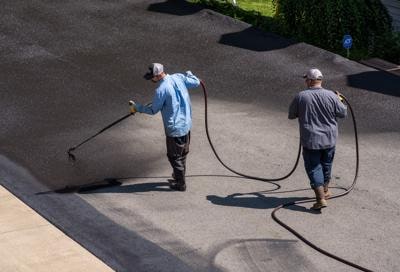Understanding Tilted Parking: How Asphalt Sealing Enhances Commercial Great Deals
Understanding Tilted Parking: How Asphalt Sealing Enhances Commercial Great Deals
Blog Article
Warm Mix Asphalt: A Lasting Remedy for Sidewalk
Hot Mix Asphalt (HMA) has actually emerged as a leading lasting option for sidewalk options, offering a myriad of ingenious innovations and ecological advantages. As the need for environment-friendly building practices grows, discovering the subtleties of HMA's sustainability can offer important insights right into the future of pavement remedies.
Environmental Benefits of Warm Mix Asphalt

Moreover, Warm Mix Asphalt assists to minimize metropolitan warmth island results. Its dark shade takes in sunlight, decreasing the amount of warmth mirrored back right into the environment compared to lighter-colored pavements. This can lower ambient temperature levels in city locations, reducing the demand for cooling and ultimately minimizing energy usage.
On top of that, Warm Mix Asphalt adds to improved stormwater monitoring. Its porous nature permits water to infiltrate the pavement and charge groundwater products, decreasing drainage and the danger of flooding. These ecological benefits make Hot Mix Asphalt a sustainable option for paving roads and highways.
Power Effectiveness in HMA Manufacturing
Is energy efficiency a critical variable in the production of Hot Mix Asphalt (HMA)? Energy plays a substantial function in the production of HMA, affecting both price and ecological sustainability. One vital aspect of energy efficiency in HMA production is the use of cozy mix asphalt (WMA) innovations.
In addition, improvements in plant innovations have led to even more energy-efficient HMA manufacturing processes. By maximizing power use in HMA production, the market can reduce its carbon impact while preserving high-quality sidewalk materials.
Recyclability of Hot Mix Asphalt
The recyclability of Hot Mix Asphalt (HMA) is a pivotal element of its sustainability and lasting ecological impact. HMA is one of the most recycled materials in the United States, with over 100 million lots of reclaimed asphalt sidewalk (RAP) being recycled every year in new sidewalk building. Reusing HMA offers numerous environmental benefits, such as look here minimizing the need for virgin products, lowering energy consumption throughout production, and lowering the amount of waste sent to landfills.
The procedure of reusing HMA entails milling the existing pavement, squashing it right into smaller sized items, and blending it with new accumulation and asphalt binder to produce a recycled mix. On the whole, the recyclability of HMA plays a significant duty in advertising sustainable practices within the pavement industry.

Long-Term Performance of HMA
Asphalt sidewalks show sturdiness and resilience over an extensive duration, mirroring the lasting performance of Warm Mix Asphalt (HMA) In addition, developments in HMA innovation, such as the use of polymer-modified binders and cozy mix asphalt, have actually further enhanced the sturdiness and longevity of HMA pavements. By focusing on quality building and upkeep practices, HMA continues to confirm itself as a sustainable and cost-efficient option for durable sidewalk infrastructure.

HMA: Resilience and Sustainability
Demonstrating both sturdiness and sustainability, Hot Mix Asphalt (HMA) has actually become a foundation in the construction of lasting pavement infrastructures - angled parking. HMA's durability originates from its ability to withstand hefty loads, rough climate condition, and high traffic quantities, making it a reputable selection for streets, freeways, and airport paths. The make-up of HMA, which typically includes aggregates, binder, and filler, plays a critical role in improving its longevity and resistance to tear and put on
Furthermore, HMA's sustainability exists in its recyclability and energy-efficient manufacturing process. The ability to reuse redeemed asphalt sidewalk (RAP) in brand-new HMA mixtures lowers the demand for virgin best site materials and decreases the ecological impact of pavement building and construction and upkeep. Furthermore, the power effectiveness of generating HMA hinges on its reduced mixing temperatures compared to various other pavement materials, resulting in minimized power intake and greenhouse gas exhausts.
Conclusion
In conclusion, warm mix asphalt (HMA) uses a sustainable solution for sidewalk with its ecologically pleasant characteristics. HMA's recyclability, power effectiveness in production, and lasting longevity make it a green option for road building and construction.
HMA is one of the most recycled materials in the United States, with over 100 million loads of redeemed asphalt pavement (RAP) being recycled every year in new sidewalk construction.The procedure of recycling HMA entails milling the existing sidewalk, crushing it right into smaller items, and blending it with new accumulation and asphalt binder to create a recycled mix.Asphalt sidewalks demonstrate durability and resilience over an extensive period, reflecting the lasting efficiency of Hot Mix Asphalt (HMA) Additionally, advancements in HMA modern technology, such as the use of polymer-modified binders and cozy mix asphalt, have even more boosted the sturdiness and longevity of HMA pavements. The capacity to recycle recovered asphalt sidewalk (RAP) in brand-new HMA mixes look at this web-site minimizes the need for virgin materials and lessens the ecological impact of pavement building and construction and maintenance.
Report this page